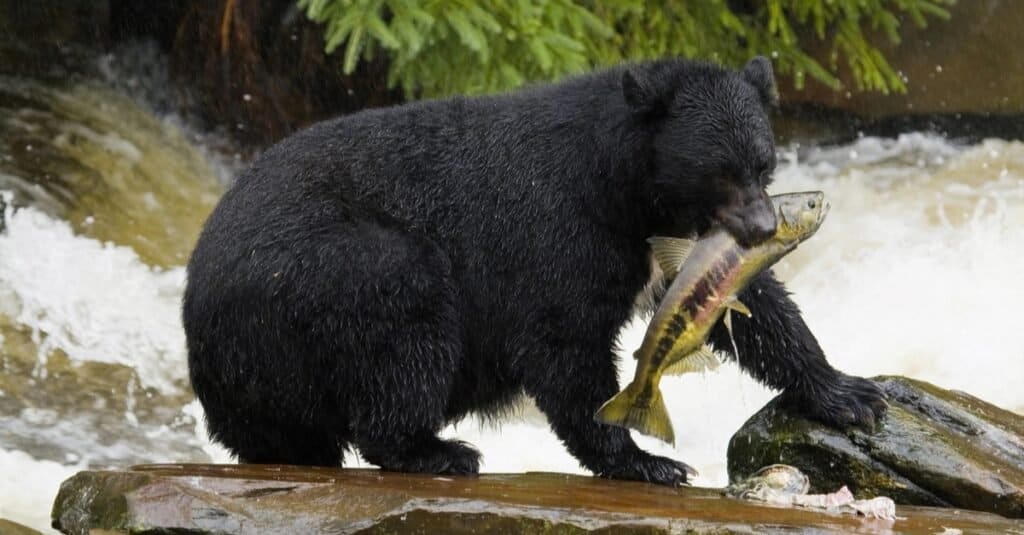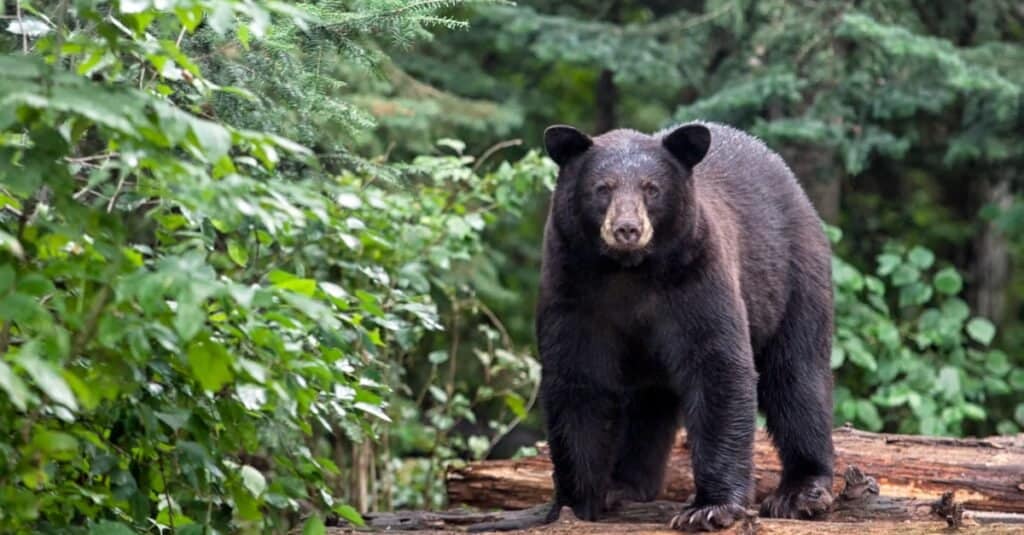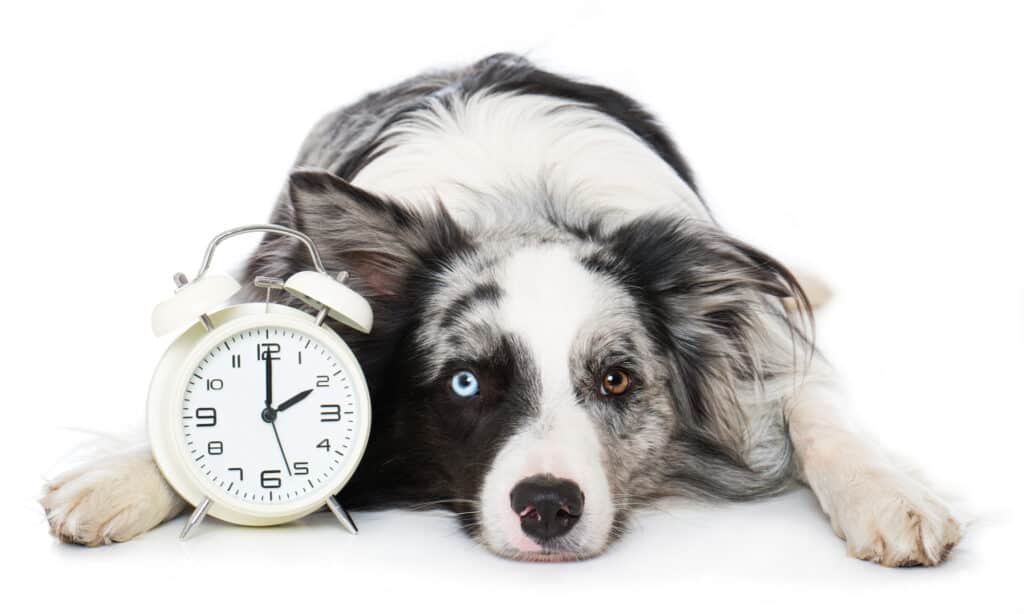Are black bears nocturnal or diurnal? Or is it possible that they are something else? Most people think black bears are strictly crepuscular (most active at dawn and dusk) animals. However, recent research shows that they may be more flexible in their sleep behavior than previously thought. Follow as we explore black bears’ sleep behavior and the implications for these predators.
What Exactly Are Black Bears?

Are all
black bears
nocturnal? The American
black bear
is more crepuscular than nocturnal, preferring to hunt during the twilight hours.
©emperorcosar/Shutterstock.com
The American black bear, or as some people refer to it, the baribal, is a fascinating species. This small but resilient bear lives throughout much of the continental United States and Canada. Due to its wide distribution and sizable population, the American black bear is not in danger of extinction. The International Union for Conservation of Nature (IUCN) confirms this status.
This adaptable animal is exceptionally well-equipped for survival. Thanks to their skillful foraging abilities and remarkable ability to thrive even in highly disturbed habitats, black bears are master survivalists. Indeed, the sheer ubiquity and resilience of the American black bear make it one of the most fascinating animals on the continent.
Do Black Bears Sleep at Night or During the Day?
Black bears are well known for their distinctive sleeping habits. This behavior makes many people wonder whether black bears are diurnal and sleep at night or are nocturnal and sleep during the day, and black bears may do both, depending on the season and other factors.
These bears are generally crepuscular, so they are busiest during the twilight periods at dawn and dusk. Black bears spend most of the daylight doing very little, taking several short naps during this period. Then they sleep for much of the night, except for a few hours around sunset when looking for food. However, these patterns can also vary depending on food availability and seasonal changes.
Why Do Black Bears Sometimes Exhibit Nocturnal Behavior?
There are several possible reasons why crepuscular black bears may periodically exhibit nocturnal behavior. However, this nocturnal behavior in black bears is primarily a result of changes in their environment caused by human activities. Black bears that frequent heavily-populated areas such as dumps or campsites will often shift their natural crepuscular activity pattern to nocturnal to avoid humans.
This behavior can benefit the bears and the people living nearby. This benefit is due to the reduction of likely conflicts between humans and wildlife. In undisturbed habitats, they would ultimately exhibit crepuscular behavior much of the time.
How Much Sleep Do Black Bears Get Daily?
As anyone who has witnessed the activity of a black bear in the wild can attest, these animals are not known for their dedication to getting a full night’s sleep at certain times of the year. In fact, during transitional seasons like spring and fall, they tend to focus primarily on finding food. This focus often means that they only sleep for about four hours a day or night.
In the summer months, however, bears find more opportunities for rest. They may nap intermittently throughout the day and then get the most sleep at night. On average, in the summertime, they will get a similar amount of sleep as we do (typically 6-7 hours). Even so, their innate survival instincts ensure that they are well-adapted to their environment. So, they are highly efficient at conserving energy when sleeping opportunities arise.
Do Black Bears Hibernate?

Black bears do not sleep much during the warmer months, preferring to fatten up for hibernation during
winter
.
©iStock.com/Lynn_Bystrom
Yes, even though they are not nocturnal and don’t sleep much in summer, black bears make up for this by hibernating in winter. Often considered one of the fascinating aspects of these animals’ natural behaviors, hibernation is a unique physiological state that enables them to survive during the coldest months of the year. During this time, a black bear’s body undergoes many drastic changes, including a reduction in heart rate and blood flow, a drop in body temperature by about 10 degrees, and a near-halving of its regular metabolic rate.
They also remain dormant without eating or relieving themselves for three to seven months. Black bears will only wake up if something disturbs their slumber. To achieve this hibernation level, these bears typically seek out dens or shelter under rocks or hollow trees or even snuggle down in sheltered brush piles. Their ability to hibernate is essential for their long-term survival in harsh winter environments.
Where Do Black Bears Sleep During Spring and Fall?
When black bears are not hibernating, they can sleep in various locations. Black bears seem comfortable sleeping just about anywhere as long as they are not disturbed. For instance, you might see a bear dozing under or between the branches of a tree or resting in a large pile of leaves.
Another common area for black bears to nap is in a natural den, such as those formed by fallen trees or other structures. Regardless of where they spend their time when they’re not awake, one thing is sure: they sleep just about wherever suits them.
Transitional Phases Before and After Hibernation
How the black bear prepares for hibernation and wakes up after a long winter reflects the overall impact of these periods on the animal’s sleep and activity patterns. To prepare, black bears focus almost exclusively on eating during the months before hibernation begins. As a result, they sleep very little and instead dedicate all of their energy to obtaining enough food to survive through the winter.
When they wake up from hibernation in springtime, black bears initially focus primarily on waking up. Then they work on getting their muscles and other bodily functions back online after lying dormant for months. During this transition, they rarely sleep, eating up to 20 hours daily.
These two transitional phases highlight essential aspects of how black bears manage their sleep and activity at different points throughout their lives. Ultimately, this routine suggests that a bear’s sleep cycle has far-reaching effects in terms of its cognitive and physical well-being.
Do Black Bears Have Poor Eyesight?
Some people assume that black bears have poor eyesight due to their tendency to rely on their senses of smell and hearing. This assumption is untrue. The black bear’s vision is about the same as humans, with certain exceptions depending on age and species. For example, black bears around ten years old or older tend to have more degraded eyesight than younger bears. Additionally, black bears have a visual adaption that helps them see better in low-light conditions than humans. So, where people struggle to see well in the dark, black bears see better in nocturnal light.
Do Black Bears Have Binocular Vision?
Yes, they have binocular vision but limited depth perception compared to other large predators. Black bears are slightly near-sighted; however, they still have a remarkable ability to see in three dimensions, just like humans. This ability allows them to accurately judge the distance between themselves and potential prey items or obstacles during hunting or movement, which ultimately helps them to survive in their natural environment. Thus, while it remains unclear whether black bears see precisely as humans, they are an intelligent and adaptive species overall.
Can the Baribal See in Color?

American black bears may not be nocturnal, but they can see well in the day and night. They can also
see color
.
©Jim Cumming/Shutterstock.com
Many people wonder whether black bears can see color, and the answer is yes. This ability is evident from their visual anatomy. Black bears have a higher density of cones than rods in their eyes. This eye structure indicates that they rely heavily on their ability to perceive color to navigate and forage in their environment. They see blue hues exceptionally well but less so in red and orange.
Not Nocturnal, but Black Bears Can See Well in the Dark
Yes, black bears can indeed see well in the dark. Their large pupils, retina-reflecting layer, and critical concentration of light-sensitive rods allow them to capture and process an abundance of light. This capability is vital when navigating dimly lit environments. Black bears also have excellent smell and hearing, which aids vision by providing additional information and context when making nighttime decisions.
Ultimately, it seems clear that black bears are masters of sight in their crepuscular activity patterns’ dimmer hours and the night’s darkest hours. Because of these advantages, nocturnal black bears can thrive in the most challenging environments, making them one of the most adaptable and resilient animals on earth.
Nocturnal vs. Diurnal: What’s The Difference?
Navigate to Nocturnal vs. Diurnal: What’s The Difference? for further information about the nocturnal and diurnal phenomenon in various living creatures.
What is the difference between nocturnal and crepuscular?

Active hours for animals often depend on how much they rely on their eyesight.
©Dora Zett/Shutterstock.com
Now, let us take a look at the difference between nocturnal and crepuscular animals. Crepuscular derives from the mid-17th century Latin word crepusculum, which translates to ‘twilight’. While the nocturnal animals are awake and active throughout most of the time after the sun goes down and things go dark, these critters find their stride just after the sun dips down over the horizon or is about to peak over.
Because the active hours for animals are generally predicated on how they utilize their eyesight, crepuscular animals probably have good lowlight vision. There are other factors to consider as well, such as environmental temperature and the activities of predators or prey. It all comes down to how the animal evolved over time to survive the best!
While twilight covers both early and late, there are distinctions for animals that are active after sunset and before sunrise. They are vespertine and matutinal, respectively.
The photo featured at the top of this post is © BGSmith/Shutterstock.com
Sources
- American Association for Anatomy, Available here: https://anatomypubs.onlinelibrary.wiley.com/doi/full/10.1002/ar.24472
- State of Alaska · Department of Fish and Game, Available here: https://www.adfg.alaska.gov/index.cfm?adfg=wildlifenews.view_article&articles_id=135
- BioOne, Available here: https://bioone.org/journals/western-north-american-naturalist/volume-71/issue-3/064.071.0306/Activity-Patterns-of-Black-Bears-in-Relation-to-Sex-Season/10.3398/064.071.0306.short
- John Wiley & Sons, Available here: https://wildlife.onlinelibrary.wiley.com/doi/abs/10.1002/jwmg.21744
- John Wiley & Sons, Available here: https://onlinelibrary.wiley.com/doi/full/10.2981/wlb.2004.033
Thank you for reading! Have some feedback for us? Contact the AZ Animals editorial team.






